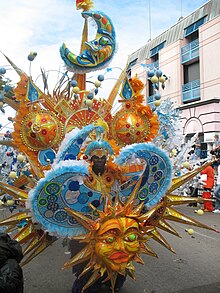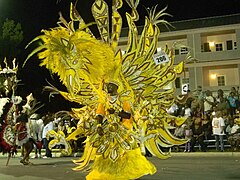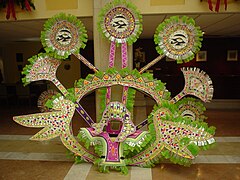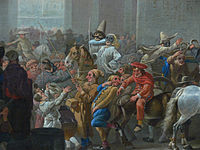Junkanoo
| Junkanoo | |
|---|---|
 Junkanoo (or "John Canoe") celebrants (Kingston, Jamaica, Christmas 1975) | |
| Status | Active |
| Genre | Folk festival, street festival, parade |
| Country | Caribbean |
| Music of the Anglophone Caribbean | ||||
| Genres | ||||
|---|---|---|---|---|
|
|
||||
|
|
||||
| Regional music | ||||
|
||||
Junkanoo is a festival that was originated during the period of African chattel slavery in British American colonies. It is practiced most notably in Jamaica, The Bahamas, and Belize as well as historically in North Carolina and where there are significant settles of West Indian people during the post-emancipation era, including Miami. In the present day, there are considerable variations in performance and spelling but there are the shared elements of masquerade (or masking), drumming, dance and parading.
In many territories, Jankunu is observed around Boxing Day (26 December), New Year's Day (1 January), and Easter holiday in some countries. These Christmas time cultural parades are predominantly showcased in Jamaica.[1] In The Bahamas it is originally called Junkanoo and is said to date back to the 1700’s and is celebrated year round, and Belize.[2] where the music is also mainstreamed, and competition results are hotly contested.[3] There are also Jankunu parades in Miami in June and Key West in October, where local black populations have their roots in the Caribbean.
Origins
Its origin is assumed to have begun in The Bahamas, but is claimed by several other islands in the English speaking Caribbean. However, evidence shows that Jankunu origin points strongly to Jamaica, and was later spread throughout the Caribbean as early as the 18th century, and possibly earlier.[2] Though stemming from the same origin, each celebration has been localized by different countries, and over time, evolved to be somewhat different.
This tradition is one of the oldest dance celebration in Jamaica.[4] In addition to being a cultural dance for the Garifuna people,[5][6] this type of dancing is also performed in The Bahamas on their independence day and other historical holidays.
Historically, Junkanoo parades were also found in southeastern North Carolina that can be traced back to Jamaican roots.[7] However, the custom became less popular after slavery was abolished. The last known Jankunu celebration in the Southern United States was in Wilmington, North Carolina, in the late 1880s.[8]
Dances are choreographed to the beat of goatskin drums and cowbells.
History
The festival may have originated several decades ago, when enslaved Africans or their descendants, on the plantations in Jamaica celebrated holidays granted around Christmastime. This was done with dance, music (drumming), and costumes. The costumes and drumming used in celebration in Jamaica shows strong similarities to West Africans mask dances.
Contribution made to the origins of this Jamaican tradition could be found in three “ groups” of West African festival traditions. These are;
- the annual New Yam Festival of the Mmo secret society of the Igbo peoples
- the Egungun masquerades of the Yoruba people, and
- the Homowo yam festival of the Ga people[9]
In Countries like The Bahamas after emancipation, the tradition continued and junkanoo evolved far from a simple origins to a formal, organized parade with intricate costumes, themed music and official prizes within various categories.
The origin of the word junkanoo is disputed. Theories include that it is named after a folk hero named John Canoe or that it is derived from the French gens inconnus (unknown people), as masks are worn by the revelers.[10]
Douglas Chambers, professor of African studies at the University of Southern Mississippi, suggests a possible Igbo origin from the Igbo yam deity Njoku Ji referencing festivities in time for the new yam festival. Chambers also suggests a link with the Igbo okonko masking tradition of southern Igboland, which feature horned maskers and other masked characters in similar style to jonkonnu masks.[11]
Similarities with the Yoruba Egungun festivals have also been identified.[12] However, an Akan origin is more likely because the celebration of the Fancy Dress Festivals/Masquerades are the same Christmas week (December 25–January 1) in the Central and Western Regions of Ghana and also John Canoe was in fact an existing Ahanta king and hero that ruled Axim, Ghana, before 1720, the same year the John Canoe festival was created in the Caribbean.[13] As Jeroen Dewulf pointed out, the term may have had a religious dimension, relating to the Akan deity Nyankompong, who was known in eighteenth-century English sources as John Company.[14]
According to Edward Long, an 18th-century Jamaican slave owner/historian, the John Canoe festival was created in Jamaica and the Caribbean by enslaved Akans who backed the man known as John Canoe. Canoe, an Ahanta from Axim, Ghana, was an ally soldier for the Germans, until one day he turned his back on them for his Ahanta people and sided with Nzima and troops in order to take the area from the Germans and other Europeans. The news of his victory reached Jamaica and he has been celebrated ever since that Christmas of 1708 when he first defeated Prussic forces for Axim. Twenty years later his stronghold was broken by neighbouring Fante forces aided by the military might of the British.
Ahanta, Nzima and Fante captives were taken to Jamaica as prisoners of war. The festival itself included motifs from battles typical of Akan fashion. The many war masks and war dance formations of Ahanta people became part of this celebration the world over, especially in the Caribbean. The elaborate masks and attire resemble Akan battledress with charms, referred to as a "Batakari".[15]
Description
Many of the colonies Jonkonnu was prominent, Jamaica, (as Jankunu, jonkonnu), The Bahamas (as Junkanoo), Virginia celebrated Jonkonnu.[11]
Historian Stephen Nissenbaum described the festival as it was performed in 19th-century North Carolina:
Essentially, it involved a band of black men—generally young—who dressed themselves in ornate and often bizarre costumes. Each band was led by a man who was variously dressed in animal horns, elaborate rags, female disguise, whiteface (and wearing a gentleman's wig!), or simply his "Sunday-go-to-meeting-suit." Accompanied by music, the band marched along the roads from plantation to plantation, town to town, accosting whites along the way and sometimes even entering their houses. In the process the men performed elaborate and (to white observers) grotesque dances that were probably of African origin. And in return for this performance they always demanded money (the leader generally carried "a small bowl or tin cup" for this purpose), though whiskey was an acceptable substitute.[16]

Popular culture
The Junkanoo parade has featured in movies including the James Bond film Thunderball (erroneously described as a local Mardi Gras-type festival), After the Sunset, and Jaws The Revenge, as well as in the season one episode "Calderone's Return (Part II)" of the 1984 television series Miami Vice, taking place on the fictitious island of St. Andrews. All of James Bond 13 novels were written in Jamaica[17]
A song titled “Junkanoo Holiday (Fallin’-Flyin’)” appears on Kenny Loggins’ 1979 album Keep The Fire. The song was written by Loggins. This song immediately follows the hit song "This Is It" on the album. “This Is It” has a fade ending that segues into “Junkanoo Holiday (Fallin’-Flyin’)”, omitting a complete break between the two songs.
In the thirteenth episode of the television show Top Chef: All-Stars, "Fit for a King", the contestants danced at a Junkanoo parade, learned about its history and competed to make the best dish for the Junkanoo King.
The post-Covid return to Junkanoo was briefly discussed across the two-part episodes 189 and 190 of Nicole Byer and Sasheer Zamata's podcast, Best Friends, documenting their trip to the Bahamas.[18][19]
Gallery
-
Rush for Peace (Freeport, Bahamas, 2011)
-
Costume sans participant after the parade
-
Junkanoo costume
-
Junkanoo costume
-
Junkanoo Festival, Nassau 2005
-
Junkanoo musician 2005
See also
- Pitchy patchy
- John Canoe, the 1708 king of Axim, after whom the practice may have been named
References
- ^ "2nd Day of Christmas – Jonkonnu". Jamaica Information Service.
- ^ a b Bilby, Kenneth (November 2007). Masking the Spirit in the South Atlantic World: Jankunu’s PartiallyHidden History (PDF). The Legacies of Slavery and Emancipation: Jamaica in the Atlantic World. New Haven, Connecticut: Yale University. p. 3.
- ^ Smith, Sloan (January 28, 2020). "Shell Saxon Superstars sweep 2019/2020 Junkanoo season". Eyewitness News. Nassau.
- ^ "2nd Day of Christmas – Jonkonnu". Jamaica Information Service.
- ^ Hamburg, Ericka (December 23, 2007). "Free to dance - Belize's liberating Jonkonnu celebration recalls a slavery-era tradition". Los Angeles Times. p. 3. Retrieved 2020-12-27.
- ^ Scaramuzzo, Gene (April 28, 1989). "African-Caribbean Music Takes Off". The Times-Picayune. p. L21 – via NewsBank.
- ^ Lasseter, M.E. (2014). "Jonkonnu, Jankunu, Junkanoo, John Canoe: Reorienting North Carolina's Practice in the American Mediterranean". Commemorative Landscapes of North Carolina | Documenting the American South. University of North Carolina - Chapel Hill. Retrieved 2023-09-05.
- ^ Brockell, Gillian (26 December 2021). "Jonkonnu: The holiday when Black revelers could mock their enslavers". The Washington Times.
- ^ Bilby, Kenneth M. (2010-01-01). "Surviving Secularization: Masking the Spirit in the Jankunu (John Canoe) Festivals of the Caribbean". New West Indian Guide / Nieuwe West-Indische Gids. 84 (3–4): 179–223. doi:10.1163/13822373-90002440. ISSN 2213-4360.
- ^ "The Joy of Junkanoo". The Islands of the Bahamas. The Bahamas Ministry of Tourism and Aviation. Retrieved 2020-12-27.
- ^ a b Chambers, Douglas B. (March 1, 2005). Murder at Montpelier: Igbo Africans in Virginia. University Press of Mississippi. p. 182. ISBN 1-57806-706-5.
- ^ Allsop, Richard (2003). The Dictionary of Caribbean English Usage. Jamaica: University of the West Indies Press. p. 776. ISBN 978-976-640-145-0.
- ^ "Fort Gross Frederiksburg, Princestown (1683)", Ghana Museums and Monuments Board.
- ^ Dewulf, Jeroen (December 2021). "Rethinking the Historical Development of Caribbean Performance Culture from an Afro-Iberian Perspective: The Case of Junkanoo". New West Indian Guide / Nieuwe West-Indische Gids. 95 (3–4): 223–253. doi:10.1163/22134360-bja10012. S2CID 237712750.
{{cite journal}}: CS1 maint: date and year (link) - ^ Long, Edward (1774). "The History of Jamaica Or, A General Survey of the Antient and Modern State of that Island: With Reflexions on Its Situation, Settlements, Inhabitants, Climate, Products, Commerce, Laws, and Government". T. Lowndes: 445–475.
{{cite journal}}: Cite journal requires|journal=(help) - ^ Nissenbaum, Stephen (1997). The Battle for Christmas. New York: Vintage Books. p. 285. ISBN 978-0679740384.
- ^ Magazine, Smithsonian; Billock, Jennifer. "Follow Ian Fleming's Footsteps Through Jamaica". Smithsonian Magazine. Retrieved 2023-04-23.
- ^ "Sasheer Was Scared To Leave Nicole Stranded In the Middle of the Ocean". Earwolf. Retrieved February 14, 2023.
- ^ "Nicole and Sasheer Regale You With the Final Chapter of Their Bahamas Trip". Earwolf. Retrieved February 14, 2023.
Further reading
- Bethel, Clement (1992). Junkanoo: Festival of the Bahamas. Macmillan Caribbean. ISBN 0-333-55469-8.
- Rommen, Timothy (1999). "Home Sweet Home: Junkanoo as National Discourse in the Bahamas". Black Music Research Journal. 19 (1): 71–92. doi:10.2307/779275. JSTOR 779275.
- Wisdom, Keith Gordon (1985). Bahamian Junkanoo: An Act in a Modern Social Drama (PDF) (PhD). University of Georgia.
- Wood, Vivian Nina Michelle (1995). Rushin' hard and runnin' hot: Experiencing the music of the Junkanoo Parade in Nassau, Bahamas (PhD). Indiana University.







